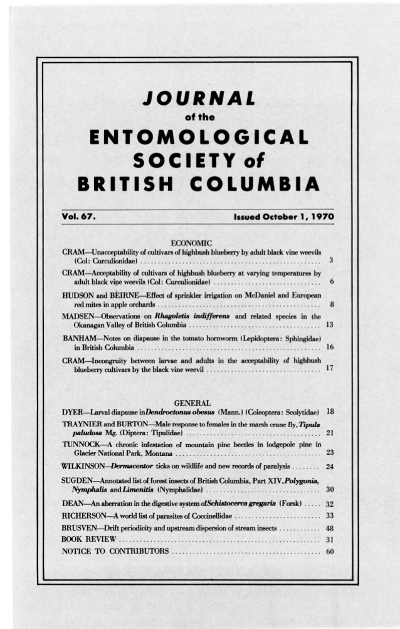<i>Dermacentor</i> ticks on wildlife and new records of paralysis
Keywords:
<i>Dermacentor</i> spp., ticks, tick paralysisAbstract
The second record of paralysis of a mule deer (<i>Odocoileus hemionus</i>) by <i>Dermacentor andersoni</i> Stiles resulted from infesting a yearling buck with 50 pairs of ticks. A yearling doe previously infested with <i>D. albipictus</i> was not paralyzed by the same infestation. Spontaneous infestations of wild and captive mule deer include an engorged nymph of <i>D. andersoni</i>. A female of <i>D. andersoni</i> weighing 746 mg was removed from a captive moose (<i>Alces alces</i>). Infesting a porcupine (<i>Erethizon dorsatum</i>) with about 14,800 larvae of <i>D. andersoni</i> produced more than 600 pairs of adults in the following year. Fifty pairs of <i>D. andersoni</i> applied to the same porcupine yielded a high proportion of engorged females, but the porcupine was not paralyzed. A coyote (<i>Canis latrans</i>) and a skunk (Mephitis mephitis) were paralyzed by 50 and 30 pairs of <i>D. andersoni</i> respectively. Few or no larvae or nymphs engorged on the skunk or on two laboratory fitches, whereas many engorged on rabbits used as controls. This suggests that Mustelidae may be resistant or unattractive to immature <i>D. andersoni</i>. Unconfirmed cases of tick paralysis in foxes have been reported. A new record is included of <i>D. andersoni</i> on a marmot (<i>Marmota monax</i>).References
Bishopp, F.C. and H.L. Trembley. 1945. Distribution and hosts of certain North American ticks. J. Parasitol. 31:1-54.
Cooley, R.A. 1938. The genera Dermacentor and Otocentor (Ixodidae) in the United States. Natl. Inst. Health Bull. No. 17l.
Cowan, I. McT. and C.J. Guiguet. 1965. The mammals of British Columbia. Handbook No. 11. Brit. Columbia Prov. Museum. Victoria, B.C.
Dawson, M.D. 1967. In: Anderson and Jones, Recent Mammals of the World. Ronald Press Company. New York.
Dodds, D.G., A.M. Martell, and R.E. Yescott. 1968. Ecology of the American dog tick, Dermacentor variabilis (Say), in Nova Scotia. Can. J. Zool. 47:171-181.
Gregson, J.D. 1958. Host susceptibility to paralysis by the tick Dermacentor andersoni Stiles (Acarina: Ixodidae). Can. Entomol. 90:421-424.
Henshaw, H.W. and C. Birdseye. 1911. The mammals of Bitterroot Valley, Montana, in their relation to spotted fever. U.S.D.A. Bur. Biol. Survey Circ. No.82.
Jellison, W.L. 1933. Parasites of porcupines of the genus Erethizon (Rodentia). Trans. Am. Microscop. Soc. 52:42-47.
Marsh, H. 1929. Some obscure diseases of sheep. J. Amer. Vet. Med. Ass. 27:724-734.
Wilkinson, P.R. 1965. A first record of paralysis of a deer by Dermacentor andersoni Stiles and notes on the " host-potential" of deer in British Columbia. Proc. Entomol. Soc. Brit. Columbia 62:28-30.
Wilkinson, P.R. 1967. The distribution of Dermacentor ticks in Canada in relation to bioclimatic zones. Can. J. Zool. 45:517-537.
Wilkinson, P.R. 1968. Phenology, behaviour, and host-relations of Dermacentor andersoni Stiles in outdoor " rodentaria", and in nature. Can. J. Zool. 46:677-689.
Wilkinson, P.R. and J.E. Lawson. 1965. Difference of sites of attachment of Dermacentor andersoni Stiles to cattle in Southeastern Alberta and in South Central British Columbia, in relation to possible existence of genetically different strains of ticks. Can. J. Zool. 43:408-411.7
Downloads
Published
Issue
Section
License
Authors who publish with the Journal of the Entomological Society of British Columbia agree to the following terms:
-Authors retain copyright and grant the journal right of first publication with the work simultaneously licensed under a Creative Commons Attribution License that allows others to share the work with an acknowledgement of the work's authorship and initial publication in this journal.
-Authors are able to enter into separate, additional contractual arrangements for the non-exclusive distribution of the journal's published version of the work (e.g., post it to an institutional repository or publish it in a book), with an acknowledgement of its initial publication in this journal.
-Authors are permitted and encouraged to post their work online (e.g., in institutional repositories or on their website) prior to and during the submission process, as it can lead to productive exchanges, as well as earlier and greater citation of published work (See The Effect of Open Access).


